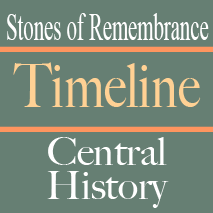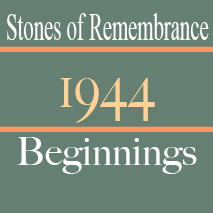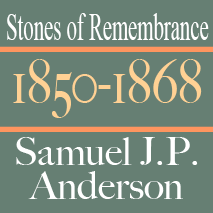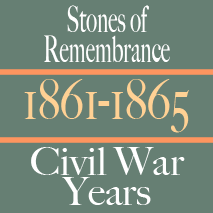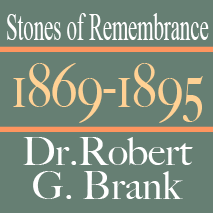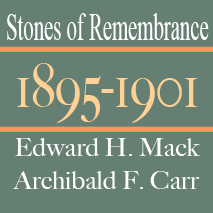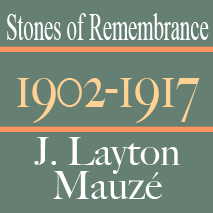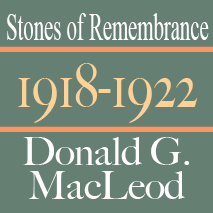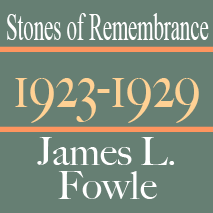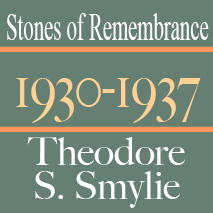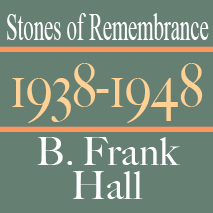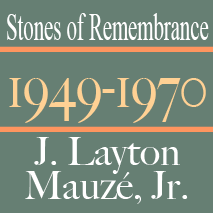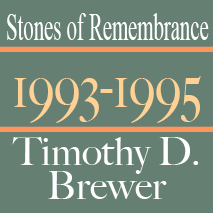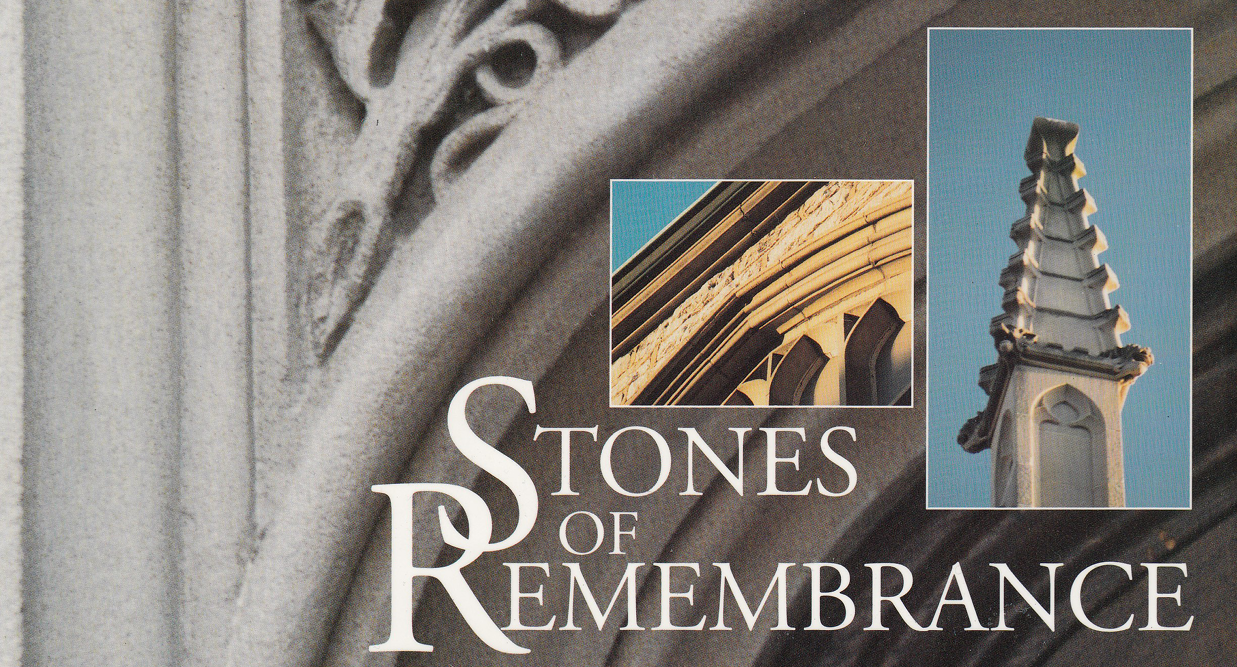
OVERVIEW
Stones of Remembrance
The original pages from Stones of Remembrance can be accessed by clicking on the title graphic of each section.
1994 was the 150th Anniversary of Central Presbyterian Church. The celebration included the publishing of a book to commemorate Central's long and eventful history. The book, titled Stones of Remembrance, was written by Marilyn McCarthy. Now out of print, sections of the original book, divided by the church's pastor tenures, have been scanned and represented below.
A timeline has also been developed to depict Central's history based on church location, pastors and the parallel events in St. Louis and U.S. history.
Click on the era's graphic to view a PDF of the pages of Stones of Remembrance.
1844-Present
Central History Timeline
For the long 170 plus years of Central Presbyterian Church's history, eras have been defined by both pastorates and locations. The pastor eras are defined below as based on the publication, Stones of Remembrance. Historical Artifacts collected and archived are defined by church locations, previous histories and church celebrations. These are listed under another tab, Historical Artifacts.
1844
Beginnings
It was a year of great disappointment for the Millerites who had predicted Christ's second coming. It was a year of great achievement for S.F.B. Morse, whose "magnetic telegraph" first tapped out "What God hath wrought." The "Great Compromiser," Henry Clay opposed James Polk for the presidency. The mighty Mississippi overflowed its banks in a record breaking flood and St. Louisans surveyed the twelve mile wide lake that formed between Second Street and the Illinois bluffs.
1845-1849
Alexander Van Court
A Martyr for Duty
The opening pages of the Session minutes record the establishment of the young church: the election of three trustees, the first collection of $6.38 for the Board of Domestic Missions and the receiving of new members. Rev. Joseph Templeton served as temporary pastor. The congregation first met for the purpose of choosing a permanent pastor in August, 1844, but action was indefinitely postponed for lack of a quorum. When Rev. Templeton announced his intention to resign in December, 1844, the search for a pastor began in earnest. The following May, an election was held between Rev. Alexander Van Court and Rev. William McCalla. Van Court won by a vote of 17 to 1. When it was determined that a sufficient subscription could be raised ($1,000 a year to be paid quarterly and a comfortable dwelling), the call was issued to Rev. Van Court. He first appears in the records in August, 1845.
1850-1868
Samuel J.P. Anderson
“The Silver Tongued Orator”
Almost immediately, the Session began the search for a successor to Rev. Van Court. In August they wrote to Professor J.H. Thornwell of Columbia, South Carolina. Thornwell was a well known theologian whose doctrine of the spiritual church, emphasizing a strict separation of church and state, would greatly influence Presbyterians in the South in the coming decade. Thornwell was much in demand and the Clerk of the Session learned informally “that there was but little prospect of a favorable response.” Even before receiving his formal declination, the Session sent letters to four additional prospects.
1861-1865
Civil War Years
"The war is wrong and I shall not pray for it.”
Lynch's Slave Market, an active slave trading venue in the 1850's, was located between Fourth and Fifth Street on Locust Street, just six blocks from Central. (Lynch's Slave Market, 1850", a daguerreotype by Thomas M. Eastery, Missouri Historical Society)
Lynch’s Slave Market, an active slave trading venue in the 1850’s, was located between Fourth and Fifth Street on Locust Street, just six blocks from Central. (Lynch’s Slave Market, 1850, a daguerreotype by Thomas M. Eastery, Missouri Historical Society)
St. Louisans were no strangers to slavery. Missouri had entered the Union as a slave state amid great controversy in 1821. Slavery lay at the heart of the bloody border wars between Missouri and Kansas in the 1850’s, where men “went at each others’ throats like bloodhounds,” according to Dr. Anderson. Because of the city’s location, St. Louis was a center for the domestic slave trade with connections to Natchez and New Orleans. Many “Negro dealers” operated in the city, including Bernard Lynch, whose slave pen was located within walking distance six block of Central.
1869-1895
Robert G. Brank
“With rarest devotion”
As they had done eighteen years before, Central elders immedi ately began the search for a new pastor by writing to a prominent Southern clergyman; in this case, Dr. Moses Hoge of Richmond, Virginia. Hoge declined and the Session then wrote to Dr. W J. Lowry of Selma, Alabama. In November 1868, Dr. Lowry also declined the call. Rather than call a third man right away, the Session deferred the matter and gave it further prayerful consideration. Two months later, they invited Robert Brank to visit the church and he accepted the invitation. He preached to the congregation and met with the Session, but declined to entertain a call. Just as the Session was preparing to write to yet another minister, Dr. Brank reconsidered and in May, 1869 became Central's third pastor.
1895-1901
Edward H. Mack & Archibald F. Carr
“Let us not think too highly of ourselves”
Dr. Brank’s death was not unexpected and Rev. Mack was immediately invited to stay on as interim pastor, soon becoming Central’s permanent pastor.
Edward H. Mack was born in Charleston, South Carolina in 1868. A brilliant student, he graduated from Princeton Seminary at 21, did further study at the University of Berlin and was awarded three doctorates in his lifetime. Because of his youth, Rev. Mack declined a call to a pastorate in North Carolina, opting instead to serve as Dr. Brank’s associate in 1893. He would stay on at Central until 1897.
1902-1917
J. Layton Mauze
“About my Father’s business”
Efforts to secure a new pastor were not detailed in the official church records beyond the appointment of a three-man search committee in March, 1901. Sometime in the winter of 1901-1902, J. Layton Mauze of Virginia was called and on January 19, 1902, the Session recommended that the deacons contribute $100 toward his moving expenses. On March 2, 1902, Dr. Mauze was installed as Central’s sixth pastor. His fifteen year ministry would be characterized by harmony and growth within the church.
1918-1922
Donald G. MacLeod
“I have been manacled”
Although it was a relatively short time that Central was without a pastor, the six months between Dr. Mauze’s resignation and the selection of a new man were characterized by the Session as “trying and critical times.” There were those who were “discouraged and disheartened that a suitable pastor could not be more speedily procured.” With a sense of relief as well as hope, Dr. Donald Macleod was called in December, 1917. He was promised a $5,000 salary and two months vacation each year.
Donald Campbell Macleod was an anomaly among Central’s pastors. All previous pastors were Southerners: Dr. Macleod was a Canadian from Nova Scotia. He had previously served congregations in Washington, D. C., and Springfield, Illinois, and was installed as Central’s seventh pastor on January 13, 1918.
1923-1929
James L. Fowle
"Laboring Together"
A committee was formed in February, 1923, to begin the search for a successor to Dr. Macleod. Many names were suggested and considered. One early possible candidate, James Fowle, was dismissed because of his youth. As one elder noted, “we require a man of experience to run a city church.” Nevertheless, it was young Mr. Fowle who received the unanimous recommendation of the committee on September 12, 1923. The congregation voted favorably on the following Sunday, and Mr. Fowle was ordained and installed as pastor on his 26th birthday, October 14, 1923.
1930-1937
Theodore S. Smylie
"In the Master's Service"
A week before construction formally began, Central called a new pastor, T. S. Smylie. Theodore Shaw Smylie was born in Jackson, Louisiana, in 1893, the son and grandson of Southern Presbyterian ministers. He received his theological education at Louisville Seminary and Westminster College. Following service as an army chaplain in the First World War, Smylie ministered in West Virginia, Kentucky and Tennessee before accepting the call to Central in November, 1930. He preached his first sermon on January 11, 1931, at the Masonic Temple on Delmar, where the congregation was meeting until their new facility was completed.
1938-1948
Benjamin Frank Hall
"Old Thngs Passed Away"
Even before Dr. Smylie resigned in March of 1937, the officers of the church had begun preparing for his successor. In November, 1936, the joint boards of elders and deacons selected a committee of five officers to choose “the man who, in their judgment, is best qualified to meet the requirements of the pastorate in our church.” A year later, they presented their choice to the congregation. He was Dr. B. Frank Hall of North Carolina.
Benjamin Franklin Hall, born in North Carolina in 1908, was regarded as “one of the most brilliant and promising of the younger ministers in the Southern Presbyterian Church.” He was a Phi Beta Kappa graduate of Davidson College and the youngest man to earn a Doctor of Theology degree from Union Theological Seminary. He had pastored a missions church in Morehead City, North Carolina and had written numerous articles for the denomination on youth programs, an interest that continued during his years at Central.
1949-1970
J. Layton Mauze, Jr.
"In His Name We Build"
Layton Mauze, Jr. was born in 1908 during his father’s years at Central. Like his father, he was a graduate of Union Theological Seminary Westminster College. He also followed his father’s footsteps in his and ministry, serving only churches in which his father had served: First Church in Huntington, West Virginia; Central Church in Kansas City; Central Church in St. Louis. In his formal acceptance of Central’s call, Dr. Mauze acknowledged the magnitude of the task facing him. “It is well that you should know,” he wrote, “that I would never have consented to touch it but for two things — a growing awareness in regard to it of Divine constraint and direction, and the knowledge that you were completely unanimous and enthusiastic in extending the invitation.” This would prove to be a successful match; Dr. Mauze would serve Central until his retirement.
1970-1991
Andrew A. Jumper
“The main thing…”
In February, 1970, when Dr. Mauzé announced his plans to retire, he signaled his intent to depart by the following August. As a result, the Session promptly formed a search committee to call a successor. By July, the committee had a candidate to bring before the congregation. He was Andrew A. Jumper, “the young man from Texas.” Following the congregation’s vote to call Dr. Jumper on Sunday, July 12, the chairman of the search committee, Vern Schneider, telephoned Dr. Jumper’s church in Lubbock. Dr. Jumper’s teenaged son, Mark, took the call and relayed the message to his father in the pulpit. Dr. Jumper advised his own congregation of his acceptance and his son was able to pass on the message to the waiting Mr. Schneider.
1993-1995
Timothy D. Brewer
"Becoming what we already are..."
The Pastoral Search Committee had been at work since January, 1992. After an extensive process, the committee recommended that the congregation call Dr. Timothy Brewer as Central’s thirteenth pastor. The congregation agreed, and Dr. Brewer’s official pastorate began October 1, 1993. Timothy D. Brewer was born in Colorado in 1958, the son of a Presbyterian minister. He graduated from Colorado State University in 1982 and pursued theological studies at Princeton Seminary, Fuller Seminary (M. Div., 1986) and Eastern Baptist Seminary (D. Min., 1992). Following work as a youth pastor in California and missionary in the Philippines and Kenya, he served churches in Michigan and California.

